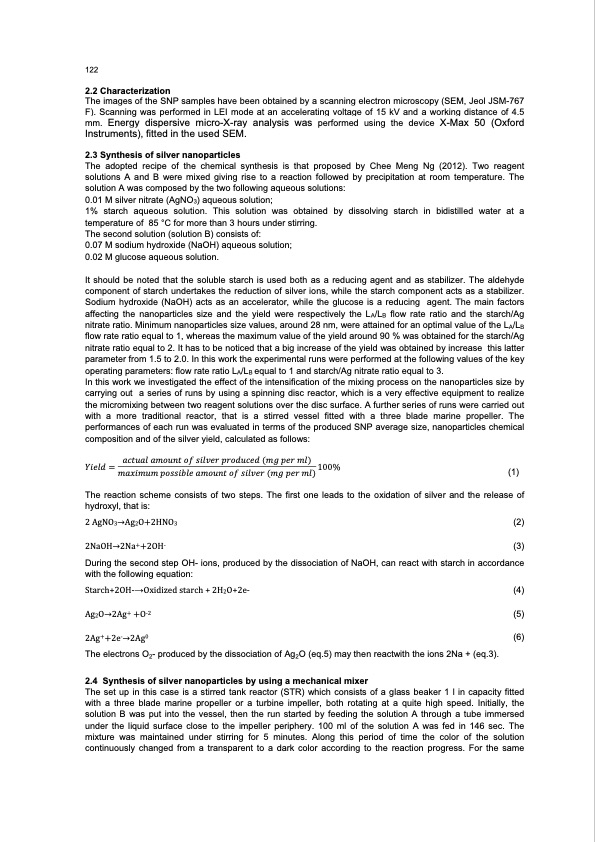
PDF Publication Title:
Text from PDF Page: 002
122 2.2 Characterization The images of the mm. Energy dispersive micro-X-ray analysis was Instruments), fitted in the used SEM. 2.3 Synthesis of silver nanoparticles The adopted recipe of the chemical synthesis is that proposed by Chee Meng Ng (2012). Two reagent solutions A and B were mixed giving rise to a reaction followed by precipitation at room temperature. The solution A was composed by the two following aqueous solutions: 0.01 M silver nitrate (AgNO3) aqueous solution; 1% starch aqueous solution. This solution was obtained by dissolving starch in bidistilled water at a temperature of 85 °C for more than 3 hours under stirring. The second solution (solution B) consists of: 0.07 M sodium hydroxide (NaOH) aqueous solution; 0.02 M glucose aqueous solution. It should be noted that the soluble starch is used both as a reducing agent and as stabilizer. The aldehyde component of starch undertakes the reduction of silver ions, while the starch component acts as a stabilizer. Sodium hydroxide (NaOH) acts as an accelerator, while the glucose is a reducing agent. The main factors affecting the nanoparticles size and the yield were respectively the LA/LB flow rate ratio and the starch/Ag nitrate ratio. Minimum nanoparticles size values, around 28 nm, were attained for an optimal value of the LA/LB flow rate ratio equal to 1, whereas the maximum value of the yield around 90 % was obtained for the starch/Ag nitrate ratio equal to 2. It has to be noticed that a big increase of the yield was obtained by increase this latter parameter from 1.5 to 2.0. In this work the experimental runs were performed at the following values of the key operating parameters: flow rate ratio LA/LB equal to 1 and starch/Ag nitrate ratio equal to 3. In this work we investigated the effect of the intensification of the mixing process on the nanoparticles size by carrying out a series of runs by using a spinning disc reactor, which is a very effective equipment to realize the micromixing between two reagent solutions over the disc surface. A further series of runs were carried out with a more traditional reactor, that is a stirred vessel fitted with a three blade marine propeller. The performances of each run was evaluated in terms of the produced SNP average size, nanoparticles chemical composition and of the silver yield, calculated as follows: SNP samples have been obtained by a scanning electron microscopy (SEM, Jeol JSM-767 F). Scanning was performed in LEI mode at an accelerating voltage of 15 kV and a working distance of 4.5 performed using the device X-Max 50 (Oxford = ( ) 100% ( ) (1) The reaction scheme consists of two steps. The first one leads to the oxidation of silver and the release of hydroxyl, that is: 2 AgNO3→Ag2O+2HNO3 (2) 2NaOH→2Na++2OH- (3) During the second step OH- ions, produced by the dissociation of NaOH, can react with starch in accordance with the following equation: Starch+2OH-→Oxidized starch + 2H2O+2e- (4) Ag2O→2Ag+ +O-2 (5) 2Ag++2e-→2Ag0 (6) The electrons O2- produced by the dissociation of Ag2O (eq.5) may then reactwith the ions 2Na + (eq.3). 2.4 Synthesis of silver nanoparticles by using a mechanical mixer The set up in this case is a stirred tank reactor (STR) which consists of a glass beaker 1 l in capacity fitted with a three blade marine propeller or a turbine impeller, both rotating at a quite high speed. Initially, the solution B was put into the vessel, then the run started by feeding the solution A through a tube immersed under the liquid surface close to the impeller periphery. 100 ml of the solution A was fed in 146 sec. The mixture was maintained under stirring for 5 minutes. Along this period of time the color of the solution continuously changed from a transparent to a dark color according to the reaction progress. For the samePDF Image | Reactor Configuration on the Production of Silver Nanoparticles

PDF Search Title:
Reactor Configuration on the Production of Silver NanoparticlesOriginal File Name Searched:
sdr-silver-nano.pdfDIY PDF Search: Google It | Yahoo | Bing
Turbine and System Plans CAD CAM: Special for this month, any plans are $10,000 for complete Cad/Cam blueprints. License is for one build. Try before you buy a production license. More Info
Waste Heat Power Technology: Organic Rankine Cycle uses waste heat to make electricity, shaft horsepower and cooling. More Info
All Turbine and System Products: Infinity Turbine ORD systems, turbine generator sets, build plans and more to use your waste heat from 30C to 100C. More Info
CO2 Phase Change Demonstrator: CO2 goes supercritical at 30 C. This is a experimental platform which you can use to demonstrate phase change with low heat. Includes integration area for small CO2 turbine, static generator, and more. This can also be used for a GTL Gas to Liquids experimental platform. More Info
Introducing the Infinity Turbine Products Infinity Turbine develops and builds systems for making power from waste heat. It also is working on innovative strategies for storing, making, and deploying energy. More Info
Need Strategy? Use our Consulting and analyst services Infinity Turbine LLC is pleased to announce its consulting and analyst services. We have worked in the renewable energy industry as a researcher, developing sales and markets, along with may inventions and innovations. More Info
Made in USA with Global Energy Millennial Web Engine These pages were made with the Global Energy Web PDF Engine using Filemaker (Claris) software.
Infinity Turbine Developing Spinning Disc Reactor SDR or Spinning Disc Reactors reduce processing time for liquid production of Silver Nanoparticles.
| CONTACT TEL: 608-238-6001 Email: greg@infinityturbine.com | RSS | AMP |